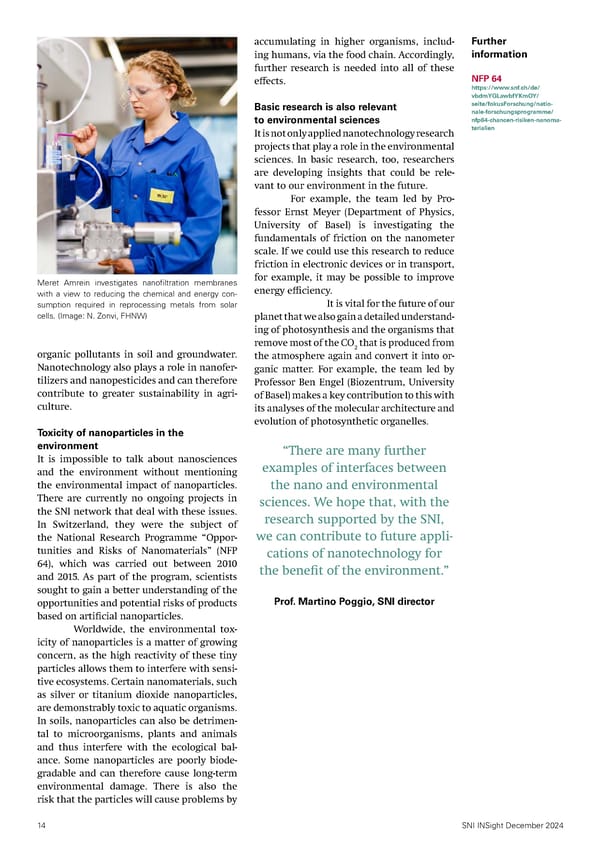accumulating in higher organisms, includ- Further ing humans, via the food chain. Accordingly, information further research is needed into all of these e昀昀ects. NFP 64 https://www.snf.ch/de/ vbdmYGLawbfYKmOY/ Basic research is also relevant seite/fokusForschung/natio- nale-forschungsprogramme/ to environmental sciences nfp64-chancen-risiken-nanoma- It is not only applied nanotechnology research terialien projects that play a role in the environmental sciences. In basic research, too, researchers are developing insights that could be rele- vant to our environment in the future. For example, the team led by Pro- fessor Ernst Meyer (Department of Physics, University of Basel) is investigating the fundamentals of friction on the nanometer scale. If we could use this research to reduce friction in electronic devices or in transport, Meret Amrein investigates nano昀椀ltration membranes for example, it may be possible to improve with a view to reducing the chemical and energy con- energy e昀케ciency. sumption required in reprocessing metals from solar It is vital for the future of our cells. (Image: N. Zonvi, FHNW) planet that we also gain a detailed understand- ing of photosynthesis and the organisms that remove most of the CO that is produced from organic pollutants in soil and groundwater. 2 the atmosphere again and convert it into or- Nanotechnology also plays a role in nanofer- ganic matter. For example, the team led by tilizers and nanopesticides and can therefore Professor Ben Engel (Biozentrum, University contribute to greater sustainability in agri- of Basel) makes a key contribution to this with culture. its analyses of the molecular architecture and evolution of photosynthetic organelles. Toxicity of nanoparticles in the environment “There are many further It is impossible to talk about nanosciences examples of interfaces between and the environment without mentioning the environmental impact of nanoparticles. the nano and environmental There are currently no ongoing projects in sciences. We hope that, with the the SNI network that deal with these issues. research supported by the SNI, In Switzerland, they were the subject of the National Research Programme “Oppor- we can contribute to future appli- tunities and Risks of Nanomaterials” (NFP cations of nanotechnology for 64), which was carried out between 2010 the bene昀椀t of the environment.” and 2015. As part of the program, scientists sought to gain a better understanding of the opportunities and potential risks of products Prof. Martino Poggio, SNI director based on arti昀椀cial nanoparticles. Worldwide, the environmental tox- icity of nanoparticles is a matter of growing concern, as the high reactivity of these tiny particles allows them to interfere with sensi- tive ecosystems. Certain nanomaterials, such as silver or titanium dioxide nanoparticles, are demonstrably toxic to aquatic organisms. In soils, nanoparticles can also be detrimen- tal to microorganisms, plants and animals and thus interfere with the ecological bal- ance. Some nanoparticles are poorly biode- gradable and can therefore cause long-term environmental damage. There is also the risk that the particles will cause problems by 14 SNI INSight December 2024
 SNI INSight December 2024 Page 13 Page 15
SNI INSight December 2024 Page 13 Page 15